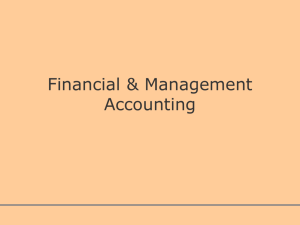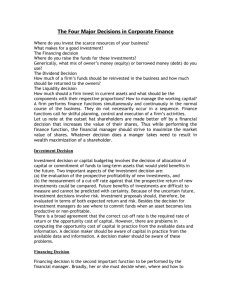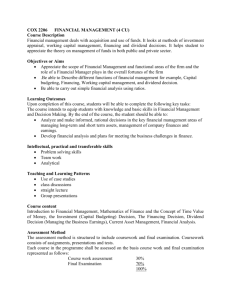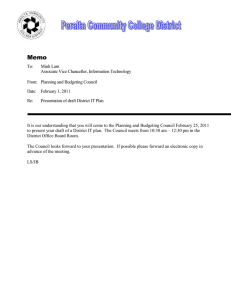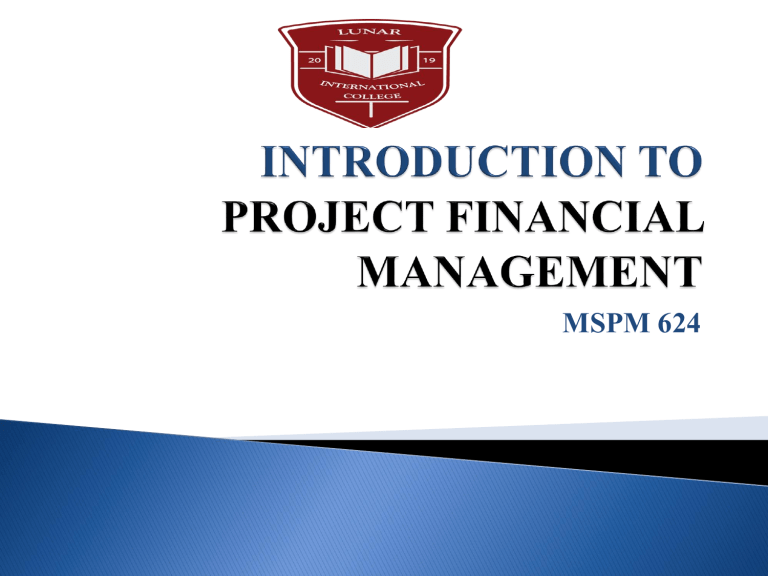
MSPM 624 1.0 Introduction Objectives Main Content 1.1 What is Financial Management? 1.2 Importance of Financial Management in Projects 1.3The finance function and its relation with other business functions 1.4 Project financial management cycle 1.5 Good practice systems: the building blocks of financial management 1.6 Key supporting policies and standards In this unit, we will attempt to explain the nature of project financial management. The unit also examines the objectives of project financial management. It also explores the functions of the finance /roles of project financial management. At the end of the unit, you should be able to: 1. Define project financial management 2. State the objectives of project financial management 3. Describe the functions of the finance/roles of project financial management Financial Management is that part of management which is concerned mainly with raising funds in the most economic and suitable manner; using these funds as profitably (for a given risk level) as possible; planning future operations, and controlling current performance and future developments through financial accounting, budgeting, statistical analysis and other means Financial management is the process of planning and controlling of the financial resources of a firm. It includes the acquisition, allocation and management of firms’ financial resources. It is concerned with how best to manage an organization’s resources in order to make sure that the resources are maximized fully. The finance functions in all their facets are concerned with decisions about investment, financing and appropriation of profit. The quality of decision taken in these aspects – investment, financing and profit distribution has a lot of implications for the success of a business. Financial management is the process of planning and controlling of the financial resources of a firm. It includes the acquisition, allocation and management of firms’ financial resources. It is concerned with how best to manage an organization’s resources in order to make sure that the resources are maximized fully. According to the World Bank Financial Management Manual: “Financial management is a process which brings together planning, budgeting, accounting, financial reporting, internal control, auditing, procurement, disbursement and the physical performance of the project with the aim of managing project resources properly and achieving the project’s development objectives”. The major objective of management is to maximize the shareholders’ wealth. The shareholders’ wealth is the present value of future cash flows or present value of future dividends payable to the shareholders infinitely. The Shareholders wealth maximization is gradually becoming the single and narrow objective of firms pursued by financial managers making it the most fashionable objective of the firm. This is being achieved through a combination of goals such as: i. Increase in the market share of the firm ii. Increase in reported profits iii. Continuous survival of the business iv. Provision of valued services to customers v. Ensuring public acceptability of the firm and its products/services coupled with both social acceptability and legal acceptability. This form of management is important for various reasons. 1. Helps organizations in financial planning; 2. Assists organizations in the planning and acquisition of funds; 3. Helps organizations in effectively utilizing and allocating the funds received or acquired; 4. Assists organizations in making critical financial decisions; 5. Helps in improving the profitability of organizations; 6. Increases the overall value of the firms or organizations; 7. Provides economic stability; 8. Encourages employees to save money, which helps them in personal financial planning. Most companies experience losses and negative cash flows during their startup period. Financial management is extremely important during this time. Managers must make sure that they have enough cash on hand to pay employees and suppliers even though they have more money going out than coming in during the early months of the business. This means the owner must make financial projections of these negative cash flows so he has some idea how much capital will be needed to fund the business until it becomes profitable. As a business grows and matures, it will need more cash to finance its growth. Planning and budgeting for these financial needs is crucial. Deciding whether to fund expansion internally or borrow from outside lenders is a decision made by financial managers. Financial management is finding the proper source of funds at the lowest cost, controlling the company's cost of capital and not letting the balance sheet become too highly leveraged with debt with an adverse effect of its credit rating. In its normal operations, a company provides a product or service, makes a sale to its customer, collects the money and starts the process over again. Financial management is moving cash efficiently through this cycle. This means that managing the turnover ratios of raw materials and finished goods inventories, selling to customers and collecting the receivables on a timely basis and starting over by purchasing more raw materials. In the meantime, the business must pay its bills, its suppliers and employees. All of this must be done with cash, and it takes astute financial management to make sure that these funds flow efficiently. Even though economies have a long-term history of going up, occasionally they will also experience sharp declines. Businesses must plan to have enough liquidity to weather these economic downturns, otherwise they may need to close their doors for lack of cash. Every business is responsible for providing reports of its operations. Shareholders want regular information about the return and security of their investments. State and local governments need reports so that they can collect sales tax. Business managers need other types of reports, with key performance indicators, which measure the activities of different parts of their businesses. As well, a comprehensive financial management system is able to produce the various types of reports needed by all of these different entities. The government is always around to collect taxes. Financial management must plan to pay its taxes on a timely basis. Financial management is an important skill of every small business owner or manager. Every decision that an owner makes has a financial impact on the company, and he has to make these decisions within the total context of the company's operations. Project Financial Management(PFM) determines how the project will be financed, including the processes to acquire and manage the financial resources for the project. It is more concerned with revenue sources and monitoring net cash-flows for the construction project than with managing day-to-day costs. Therefore to continuously monitor the project finances and to ensure the company's financial capacity to complete the project are the most critical finance manager jobs. This also includes the assessment and monitoring of financial risks and the implementation of suitable financial risk management strategies. Finance functions have been acknowledged as major in most organizations. They are identified as raising funds, investing them in assets and distributing returns earned from assets to shareholder/owners. This exercise is known as financing decision, investment decision and dividend decision. When a firm endeavors to balance the cash inflows and outflows while performing the above functions, it is called liquidity decision. Hence, the list of important finance functions includes: Long term asset-mix or investment function Capital-mix or financing function Profit allocation or dividend function Short-term asset-mix or liquidity function A business organization performs finance functions simultaneously and continuously in the normal course of its activities. The occurrence may, however, not be in sequence. Finance functions require skill and professional planning, control and execution of an organization’s activities. Investment decisions involve capital expenditures which are referred to as capital budgeting decision. This is the decision of allocating capital to long-term assets that will bring in beneficial yield (cash inflow) in the future. There are two important aspects of investment decisions: a) The evaluation of the prospective profitability of new investment; and b) The measurement of a rate against the prospective return of new investments could be compared. Risk in investment, as would be explained in the next unit, arises because of uncertainty in returns. Investment proposals should, therefore, be analyzed and evaluated in terms of both expected return and risk. This is another vital function in an enterprise. The financial manager has to identify the time, place and the technique for acquiring adequate funds to meet the enterprise’s investment needs. The central issue here is the determination of appropriate proportion of internal (equity) and external (debt) finance required by the enterprise. The mix of the two is known as the capital structure of the business organization. The Financial Manager strives to obtain and sustain the best financing mix, to optimize the capital structure, which forms the base of financing. The capital structure is said to be optimum when the market value of shares is maximized. This is the other major financial decision which affects the shareholders and the business as a whole – the decision to distribute all profits or retain same. The proportion of distribution of profit and the balance retained is subject to the firm’s policy, decision of the board of director or economic situation as applied. The proportion of profits distributed as dividend is called the dividend-payout ratio. The retention ratio is the retained portion of profits. The dividend policy is determined by its impact on the shareholder’s value. Liquidity and profitability affect investment in current assets in business organizations. Liquidity of an enterprise is affected by the level of management of current asset. Risk of illiquidity (lack of liquidity), in extreme situations, can lead to a business insolvency. Current assets if properly/efficiently managed would safeguard the business organization against risk of illiquidity. The firm needs to invest sufficient funds in current assets in order to become liquid. It would lose profitability, if more of available current assets are not utilized to earn any revenue. Financial procedures involve a lot of measures to achieve effective execution of finance function. Some important routine finance functions are: Supervision of cash receipts and payments and cash balances safeguarding. Custody and safeguarding of securities, insurance policies and other valuable papers. Taking care of the mechanical details of new outside financing. Record keeping and reporting. In recent years, the scope of finance function has widened. Finance is related to many other disciplines in that it can act as a “tool” for decision making in disciplines like administration, management, educational administration, science and technology, law, economics, etc. This is due to the fact that finance has evolved from a purely descriptive course to a normative one. That is, finance focuses on statements which enunciate rules that help to attain specified goals. Thus, each discipline makes use of the finance rules. Finance is a special functional area of business administration. Finance is more or less technical economics in that its principles are derivatives of economic principles. It is also related to mathematics in that it adapts mathematical equations or relationships to formulate models and its systematic principles. Finance also provides the basis for accounting. In other words, without finance, accounting as a course may not be as extensive as it is today and may in fact not have existed. There are also financial laws showing the relationship between finance and law as a discipline (commercial law, law relating to banking etc). Laws are normally used to regulate financial practices and such laws are normally incorporated in the law discipline. The project cycle is the framework used to design, prepare, implement, and supervise projects. The duration of the project cycle is long by commercial standards. It is not uncommon for a project to last more than four years; from the time it is identified until the time it is completed. A World Bank project consists of six stages: Identification Preparation Appraisal Negotiation/Approval Implementation/Support Completion/Evaluation Project financial management planning is the initial phase of financial management. It identifies and provides all financial requirements for the project and assigns financial management roles and responsibilities. The goals of this financial management process: Identification of sources of funds and alternatives, Investigation of possibilities of short-term financial fluctuations, Examination of the economic environment, Development of financial analysis tools, Evaluation of the most suitable legal entity, Evaluation of contractual requirements, Examination of financial impact risk factors, Tax and other financial factors planning. Good financial management involves the following four building blocks: 1. KEEPING RECORDS The foundations of all accounting are basic records that describe your earnings and spending. This means the contracts and letters for money you receive and the receipts and the invoices for things that you buy. These basic records prove that each and every transaction has taken place. They are the cornerstones of being accountable. You must make sure that all these records are carefully filed and kept safe. You must also make sure that you write down the details of each transaction. Write them down in a 'cashbook' - which is a list of how much you spent, on what and when. 2. INTERNAL CONTROL Make sure that your organization has proper controls in place so that money cannot be misused. Controls always have to be adapted to different organizations. However, some controls that are often used include: Keeping cash in a safe place (ideally in a bank account). Making sure that all expenditure is properly authorized. Following the budget. Monitoring how much money has been spent on what every month. Employing qualified finance staff. Having an audit every year. Carrying out a 'bank reconciliation' every month - which means checking that the amount of cash you have in the bank is the same as the amount that your cashbook tells you that you ought to have. 3. BUDGETING For good financial management, you need to prepare accurate budgets, in order to know how much money you will need to carry out your work. A budget is only useful if it is worked out by carefully forecasting how much you expect to spend on your activities. The first step in preparing a good budget is to identify exactly what you hope to do and how you will do it. List your activities, then plan how much they will cost and how much income they will generate. 4. FINANCIAL REPORTING The fourth building block is writing and reviewing financial reports. A financial report summarizes your income and expenditure over a certain period of time. Financial reports are created by adding together similar transactions. For instance, this might mean adding together all the money you spent on fuel, new tyres and vehicle insurance and calling them "Transport Costs". Financial reports summarize the information Keeping Records Internal Controls Budgeting Financial Reporting 1. 2. 3. 4. A good policy is: Easily understood and has a definite purpose for its creation and is linked to strategy Is flexible, can adapt to change and is suited to the culture of the organization Is developed through the involvement of employees and interested stakeholders Is communicated to all relevant people. To develop a policy you must: Discuss (including consultation with board members, employees, volunteers and service users as applicable) and agree on the final version In the case of board policy, ensure the entire board ratifies the document and builds in a date for review. Sound financial management involve long-term strategic planning, and short-term operations planning. This financial planning should become part of organization's ongoing planning process. Sound financial management is one of the most important policy development and monitoring areas of a board of directors. Financial policy is developed to reflect these different roles and responsibilities facing these two main types of boards Policies and procedures should start with the Boards’ financial responsibilities. The following areas are some of those that would benefit from written policies and be included in a financial management manual: i. Board Members financial responsibilities ii. Controls on Expenditure- who can spend what and with whose authority. iii. Controls on Income iv. Controls on Financial Accounting v. Controls on Human Resources vi. Controls on Physical Assets THANK YOU



